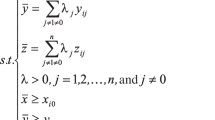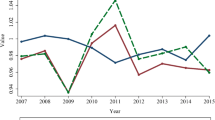Abstract
“Green development” has become the way for countries around the world to strengthen industries, and it is an important part of China’s high-quality economic development. The key for China to strike a balance between economic growth and environmental management is to optimize green total factor productivity (GTFP). This paper measures the GTFP of industry in 30 provinces of China from 2003 to 2019, based on the perspective of energy and carbon emission constraints. It empirically examines the spatial disequilibrium and dynamic evolution of industrial GTFP in China using Dagum Gini coefficients, Kernel density estimation, and Markov chain analysis. The study finds that, (1) although China’s industrial GTFP is not high, it shows an increasing trend. The industrial GTFP in the southern region is higher than that in the northern region. (2) Technical efficiency is the shortcoming of China’s industrial GTFP improvement. Technological progress is the main driving force of China’s industrial GTFP improvement. (3) The relative and absolute differences in China'’ industrial GTFP, technical efficiency, and technological progress have all shown a widening trend. Regional differences between the southern and northern regions are the main source of relative differences in industrial GTFP, technical efficiency, and technological progress. (4) China’s industrial GTFP shows a clear “club convergence” phenomenon and the “Matthew effect.” However, after the introduction of the spatial factor, the “club convergence” phenomenon and the “Matthew effect” have weakened. The driving effect of industrial GTFP on neighboring provinces is stronger in the south than in the north. This paper enriches the analysis of industrial GTFP and provides an important basis for the coordinated regional development of Chinese industry.






Similar content being viewed by others
Data availability
The datasets and materials used and/or analyzed during the current study are available from the corresponding authors on reasonable request.
Notes
See Dagum (1997) for a detailed explanation of the formula.
References
Al HM (2021) The dynamic evolution of synergies between BIM and sustainability: a text mining and network theory approach. J Build Eng 37:102159
Arabi B, Munisamy S, Emrouznejad A, Shadman F (2014) Power industry restructuring and eco-efficiency changes: a new slacks-based model in Malmquist-Luenberger Index measurement. Energy Policy 68:132–145
Barbieri E, Tommaso M, Bonnini S (2012) Industrial development policies and performances in Southern China: beyond the specialised industrial cluster program. China Econ Rev 23(3):613–625
Chen JD, Wu YY, Wen J, Cheng SL, Wang JL (2017) Regional differences in China’s fossil energy consumption: an analysis for the period 1997–2013. J Clean Prod 142(2):578–588
Chen MH, Zhang XM, Liu YX, Zhong CY (2020a) Dynamic evolution and trend forecasting of green TFP growth - an empirical study based on five major urban agglomerations in China. Nankai Econ Stud 01:20–44
Chen SY, Golley J (2014) “Green” productivity growth in China’s industrial economy. Energy Econ 44:89–98
Chen YB, Yin GW, Liu K (2020b) Regional differences in the industrial water use efficiency of China: the spatial spillover effect and relevant factors. Resour Conserv Recycl 167:105239
Chung YH, Färe R, Grosskopf S (1997) Productivity and undesirable outputs: a directional distance function approach. J Environ Manag 51(3):229–240
Cui Y, Khan SU, Deng Y, Zhao NJ (2021) Regional difference decomposition and its spatiotemporal dynamic evolution of Chinese agricultural carbon emission: considering carbon sink effect. Environ Sci Pollut Res 28(29):38909–38928
Dagum CA (1997) New approach to the decomposition of the gini income inequality ratio. Empir Econ 22(4):515–531
Dan S (2007) Regional differences in China’s energy efficiency and conservation potentials. Chin World Econ 01(77):100–119
Fan M, Shao S, Yang L (2015) Combining global Malmquist-Luenberger index and generalized method of moments to investigate industrial total factor CO2 emission performance: a case of Shanghai (China). Energy Policy 79:189–201
Färe R, Grosskopf S, Pasurka C (2001) Accounting for air pollution emissions in measures of state manufacturing productivity growth. J Reg Sci 41(3):229–240
Gebauer H (2011) Exploring the contribution of management innovation to the evolution of dynamic capabilities. Ind Mark Manage 40(8):1238–1250
Golley J (2002) Regional patterns of industrial development during China’s economic transition. Blackwell Publishers Ltd 10(3):761–801
Hang Y, Wang F, Su B, Wang YZ, Zhang W, Wang QW (2021) Multi-region multi-sector contributions to drivers of air pollution in China. Earth’s Future 9(6):e2021EF002012
He F, Zhang QZ, Lei JS, Fu WH, Xu XN (2013) Energy efficiency and productivity change of China’s iron and steel industry: accounting for undesirable outputs. Energy Policy 54:204–213
Hu JL, Sheu HJ, Lo SF (2005) Under the shadow of Asian Brown Clouds: unbalanced regional productivities in China and environmental concerns. Int J Sust Dev World 12(4):429–442
Huang HY, Wang FR, Song ML, Balezentis T, Streimikiene D (2021) Green innovations for sustainable development of China: analysis based on the nested spatial panel models. Technol Soc 65(4):101593
Jiang T, Huang S, Yang J (2019) Structural carbon emissions from industry and energy systems in China: an input-output analysis. J Clean Prod 240:118116.1-118116.13
Krugman P (1994) The Myth of Asia’ s Miracle[J]. Foreign Aff 73(6):62–78
Latif B, Gunarathne N, Gaskin J, Ong TS, Ali M (2022) Environmental corporate social responsibility and pro-environmental behavior: the effect of green shared vision and personal ties. Resour Conserv Recycl 186:106572
Li N, Pei XD, Huang YZ, Qiao JQ, Zhang YJ, Jamali RH (2022) Impact of financial inclusion and green bond financing for renewable energy mix: implications for financial development in OECD economies. Environ Sci Pollut Res 29(17):25544–25555
Li N, Wang Z, Zhang ZC (2018) Influence of plant structure and flow path interactions on the plant purification system: dynamic evolution of the SO2 pollution. Environ Sci Pollut Res 25(35):35099–35108
Liang QM, Fan Y, Wei YM (2007) Multi-regional input-output model for regional energy requirements and CO2 emissions in China. Energy Policy 35(3):1685–1700
Lin BQ, Chen ZY (2018) Does factor market distortion inhibit the green total factor productivity in China? J Clean Prod 197:25–33
Liu GT, Wang B, Zhang N (2016) A coin has two sides: which one is driving China’s green TFP growth? Econ Syst 40(3):481–498
Ma Z, Hong L (2004) Clarity and tradability of property rights is the basis for proper pricing of environment and resources. China Price 2:49–51
Mahlberg B, Luptacik M (2014) Eco-efficiency and eco-productivity change over time in a multisectoral economic system. Eur J Oper Res 234(3):885–897
Oh D (2010) A global Malmquist-Luenberger productivity index. J Prod Anal 34(3):183–197
Oh D, Heshmati A (2010) A sequential Malmquist-Luenberger productivity index: environmentally sensitive productivity growth considering the progressive nature of technology. Energy Econ 32(6):1345–1355
Pan YL, Dong F (2022) Dynamic evolution and driving factors of new energy development: fresh evidence from China. Technol Forecast Soc Chang 176:121475
Pastor JT, Lovell CAK (2005) A global Malmquist productivity index. Econ Lett 88(2):266–271
San OT, Latif B, Di Vaio A (2022) GEO and sustainable performance: the moderating role of GTD and environmental consciousness. J Intellect Cap 23(7):38–67
Shi CF, Zeng XY, Yu QW, Shen JY, Li A (2021) Dynamic evaluation and spatiotemporal evolution of China’s industrial water use efficiency considering undesirable output. Environ Sci Pollut Res 28(16):20839–20853
Tao F, Zhang HQ, Hu J, Xia XH (2017) Dynamics of green productivity growth for major Chinese urban agglomerations. Appl Energy 196:170–179
Tian P, Lin BQ (2018) Regional technology gap in energy utilization in China’s light industry sector: Nonparametric meta-frontier and sequential DEA methods. J Clean Prod 178:880–889
Tunio RA, Jamali RH, Mirani AA et al (2021) The relationship between corporate social responsibility disclosures and financial performance: a mediating role of employee productivity. Environ Sci Pollut Res 28(9):10661–10677
Wang H, Liu HF, Cao ZY, Wang BW (2016) FDI technology spillover and threshold effect of the technology gap: regional differences in the Chinese industrial sector. Springerplus 5(1):323
Wang K, Wei YM (2014) China’s regional industrial energy efficiency and carbon emissions abatement costs. Appl Energy 130:617–630
Wang K, Zhang X, Wei YM, Yu SW (2013) Regional allocation of CO2 emissions allowance over provinces in China by 2020. Energy Policy 54(1):214–229
Wang K, Wei YM (2016) Sources of energy productivity change in China during 1997–2012: a decomposition analysis based on the Luenberger productivity indicator. Energy Econ 54:50–59
Wang ZH, Feng C (2015) Sources of production inefficiency and productivity growth in China: a global data envelopment analysis. Energy Econ 49:380–389
Wei W, Zhang WL, Wen J, Wang JS (2019) TFP growth in Chinese cities: the role of factor-intensity and industrial agglomeration. Econ Model 91:534–549
Wu D (2001) A study on North-South differences in economic growth. Geogr Res 20(2):238–246
Xiao SY, Wang SS, Zeng FH, Huang WC (2022) Spatial differences and influencing factors of industrial green total factor productivity in Chinese industries. Sustainability 14(15):9229
Xu B, Lin BQ (2016) Regional differences in the CO2 emissions of China’s iron and steel industry: Regional heterogeneity. Energy Policy 88:422–434
Xu SC, He ZX, Long RY (2014) Factors that influence carbon emissions due to energy consumption in China: Decomposition analysis using LMDI. Appl Energy 127(15):182–193
Xue Y, Wen ZZ, Jie F, Jian HY, Hong YZ (2018) Transfers of embodied PM 2.5 emissions from and to the North China region based on a multiregional input-output model. Environ Pollut 235:381–393
Yin JY, Cao YF, Tang BJ (2019) Fairness of China’s provincial energy environment efficiency evaluation: empirical analysis using a three-stage data envelopment analysis model. Nat Hazards 95(10):343–362
Yu DN, Tao S, Hanan A, Ong TS, Latif B, Ali M (2022) Fostering green innovation adoption through green dynamic capability: the moderating role of environmental dynamism and big data analytic capability. Int J Environ Res Public Health 19(16):10336
Zeng P, Wei X, Duan Z (2022) Coupling and coordination analysis in urban agglomerations of China: urbanization and ecological security perspectives. J Clean Prod 365:132730
Zhou X, Zhang M, Zhou MH, Zhou M (2016) A comparative study on decoupling relationship and influence factors between China’s regional economic development and industrial energy–related carbon emissions. J Clean Prod 142(2):783–800
Zhu XW, Du JG, Boamah KB, Long XL (2020) Dynamic analysis of green investment decision of manufacturer. Environ Sci Pollut Res 27(14):16998–17012
Acknowledgements
The authors are grateful to all the people who helped complete this research and to the anonymous reviewers for their suggestions for improving the manuscript.
Funding
This research was supported by the National Social Science Fund’s major project “Research on the Formation Mechanism, Dynamic Evaluation and Policy Synergy of China’s Economic Resilience under the New Development Pattern” (21&ZD072).
Author information
Authors and Affiliations
Contributions
SW, SX, and XL contributed to the study conception and design. SW and SX participated in material preparation, data collection, and analysis. SW wrote the first manuscript draft. QZ helped revise and improve the manuscript draft. All authors read and approved the final manuscript.
Corresponding author
Ethics declarations
Ethics approval and consent to participate
Not applicable.
Consent for publication
Not applicable.
Competing interests
The authors declare no competing interests.
Additional information
Responsible Editor: Eyup Dogan
Publisher's note
Springer Nature remains neutral with regard to jurisdictional claims in published maps and institutional affiliations.
Rights and permissions
Springer Nature or its licensor (e.g. a society or other partner) holds exclusive rights to this article under a publishing agreement with the author(s) or other rightsholder(s); author self-archiving of the accepted manuscript version of this article is solely governed by the terms of such publishing agreement and applicable law.
About this article
Cite this article
Wang, S., Xiao, S., Lu, X. et al. North–south regional differential decomposition and spatiotemporal dynamic evolution of China’s industrial green total factor productivity. Environ Sci Pollut Res 30, 37706–37725 (2023). https://doi.org/10.1007/s11356-022-24697-9
Received:
Accepted:
Published:
Issue Date:
DOI: https://doi.org/10.1007/s11356-022-24697-9




